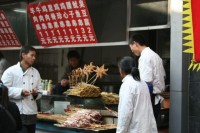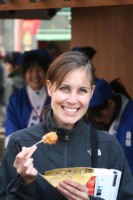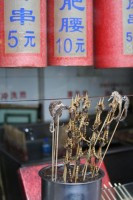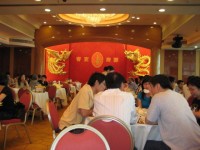Mon 5 Nov 2007
Duck – It’s What’s for Dinner
Posted by Derek under China, Food
[3] Comments
I’ve been to hundreds of Chinese restaurants in my days. They seem to be everywhere in the States, with Chinese entrepreneurs setting up shop in every shopping mall or available street corner. In many cases, the primary attraction of a Chinese restaurant is the buffet. After paying a nominal sum, you line up to gorge yourself on fried rice, eggs rolls, wanton soup and sweet and sour chicken.
Before coming to China, I had heard that the food here is completely different than the “Chinese” food found in America. That statement is as true as the statement that the Red Sox won the World Series this year (GO SOX!). We’ve been here for a month and haven’t spotted one plate of General Tso’s Chicken or Moo Goo Gai Pan (actually, I’d pay an untold sum for some General Tso’s Chicken right now, especially after the bland, and somewhat disgusting, meals Shanna and I have endured at times). In fact, we’ve been completely shocked at how little rice we’ve seen consumed. You practically have to beg for rice at most restaurants here – and soy sauce? forget about it. You might as well be asking the waiter if you can drink your tea out of the holy grail.
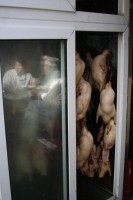
The one item I’ve seen at Chinese restaurants in the States that I was confident I would find in Beijing is roast duck (or, as we call it back home, “Beijing Duck” or “Peking Duck”). You can find Peking Duck at many Chinese restaurants in the US. Unless you go to restaurants that specialize in Peking Duck (like the wonderful Peking Duck House in New York City’s Chinatown where I recently took my mom, who has become quite an adventurous eater in recent years), you may have to order your duck a day or two in advance.

After a little research, we discovered two restaurants that were reported to excel in roast duck in Beijing – Dadong Roast Duck Restaurant and Li Qun Roast Duck Restaurant. The former, Dadong, is an upscale joint that caters to wealthy Chinese and tourists. The white tablecloth restaurant is huge and gorgeous. There must be a staff of a hundred catering to your every need. Once your duck arrives, a chef dressed in white meticulously carves the roasted goodness right in front of you.
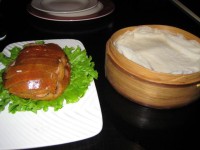
The second restaurant, Li Qun, has a completely different environment. Hidden in the hutong (the old, historic neighborhoods) south of Tiananmen Square, Li Qun has a very rustic feel. There are only a handful of tables and you must call in advance in order to ensure a duck has begun the roasting process. A diner looking for immaculate conditions in their dining experience would be better off heading to Dadong.
The process of eating duck is the same at each restaurant. The duck, including the duck skin, is sliced in front of you. You might think – duck skin? Isn’t that disgusting? Actually, the crispy duck skin is easily the best part. Keep in mind that I also think fried pork skins are a culinary delight (which have been so slandered by high-browed diners that I prefer to eat them in solitude for fear of judgment).
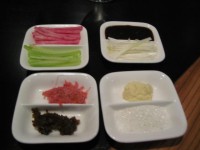
The sliced duck is accompanied by, at a minimum, three items – “pancakes”, sliced scallions and hoisin sauce (a delicious plum sauce). The pancakes are thin, translucent and round; they have very little taste as they are primarily used as a vehicle for consuming the duck. Similar to making a fajita, you stuff the pancake with duck, scallions and hoisin sauce. In some cases, additional items are available including sliced cucumbers, garlic paste and sugar (a crucial item, in our opinion). The stuffed duck pancake is nothing but fantastic.
After comparing the two restaurants, we couldn’t choose a favorite. While we liked the upscale atmosphere at Dadong, we also appreciated the old-school charm of Li Qun. The duck was exceptional at both. [embedplusvideo height=”350″ width=”450″ editlink=”http://bit.ly/1tatGZ2″ standard=”http://www.youtube.com/v/eDZ8FJUCxKM?fs=1″ vars=”ytid=eDZ8FJUCxKM&width=450&height=350&start=&stop=&rs=w&hd=0&autoplay=0&react=1&chapters=¬es=” id=”ep3994″ /]
